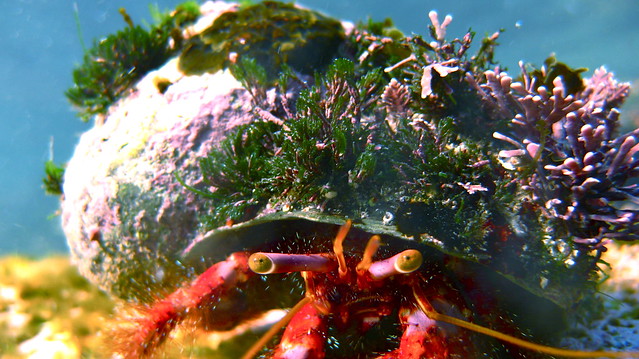 |
| Photo by Sylke Rohrlach |
Just as there are many types of hermit crabs that can be kept as pets, so too are there many different breeds which can be kept in aquariums. Not all have the same chance for survival if kept in captivity, however, and it is important that the aquarium owner make sure that they are familiar with all of the specific needs of their hermit crabs before they are introduced to the aquarium. Below is an introduction to some of the most common breeds of aquarium hermit crabs.
- Red Hermit Crab (Dardanus megistos)- Also known as the White-Spotted Hermit Crab this crab has red legs with black-edged spots. It is not a safe addition to a reef aquarium but is very useful in keeping algae growth to a minimum in a community aquarium. Only one crab per aquarium please; these crabs are very protective of their personal space.
- Red Legged Hermit Crab (Clibanarius digueti)-these Mexican crabs are a hardy addition to any aquarium, eating algae from the tank. They demand a low level of copper in the water, however, as their bodies cannot survive in the presence of this metal.
- Scarlet Hermit Crab or Reef Hermit Crab (Paguristes cadenati)-this hermit crab generally remains small, around two inches across, and has a red body with yellow eyestalks. They are very helpful in keeping the algae growth inside the aquarium under control; however, if insufficient algae are available inside the tank they must be supplementally fed with dried seaweed.
- Common Hermit Crab (Pagurus bernhardus)-These crabs are more common in Europe but can be found in other countries as well. Also known as the soldier crab.
Since these crabs carry their homes around on their backs it is important that they constantly have new shells available to them when they have outgrown their previous shell. A hermit crab in an improperly sized shell cannot grow properly. These shells can be purchased from a pet store or an online retailer or, if the owner is familiar with the requirements of their hermit crabs, these shells can often be found on a beach. If the owner chooses to go out into the wild and collect their own shells it is important that they choose the proper type of shell for their hermit crab to inhabit. As sea anemones are often an important part of the hermit crabs natural environment they make excellent tank mates, eating the leftovers when the hermit crab has finished a meal and cutting back on the amount of tank waste.
in an improperly sized shell cannot grow properly. These shells can be purchased from a pet store or an online retailer or, if the owner is familiar with the requirements of their hermit crabs, these shells can often be found on a beach. If the owner chooses to go out into the wild and collect their own shells it is important that they choose the proper type of shell for their hermit crab to inhabit. As sea anemones are often an important part of the hermit crabs natural environment they make excellent tank mates, eating the leftovers when the hermit crab has finished a meal and cutting back on the amount of tank waste.
Hermit crabs are an intriguing addition to any tank and require very little maintenance once their owners are familiar with their needs and their habits. With the proper care, they can live for quite a while, providing endless hours of joy for their owners and their families.

No comments:
Post a Comment